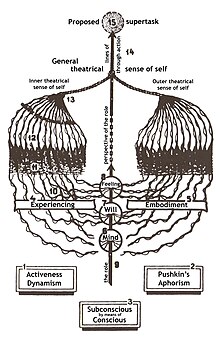Art of experiencing
The art of experiencing is a central concept in the system Konstantin Sergeyevich Stanislavsky Alexeyev in connection with his discussion of the work of the actor on himself . In contrast to imitation, the attempt to approach the unconscious or nature through conscious methods or psychotechnics and to involve them in the creative process is central to the art of experiencing .
As a key concept of the so-called Stanislawski system , this view had a formative influence on Stella Adler and Lee Strasberg's method ( method acting ).
Stanislawski summarized the art of experiencing he taught towards the end of his life as follows: “The novelty of my method is that it helps to create his own, living inner material from the soul of the creative human-artist, which is analogous to the role received ... The new, fortunate peculiarity of the process is that, through the 'life of the human body', it evokes the 'life of the human spirit', causing the artist to experience feelings that are analogous to the feelings of the person he is portraying. ”
background
In the 18th century the question arose to what extent actors should imitate or experience the feelings and passions of their role. Conrad Ekhof defined his view of the art of acting as follows: "By imitating art of nature and getting so close to it that probabilities for truths have to be assumed, or re-imagining things that have happened as naturally as if they were only happening now."
Stanislavski contrasted this art of imitation with his art of experience . For this a stage theory was necessary, which could replace the technique of imitation . Then he developed the approach of psychotechnology.
Methods
Stanislawski stated that for a natural, organic and creative game it is necessary that the actors are able to grasp their role unconsciously and intuitively. Therefore he developed methods and techniques with which the actors are able to achieve this unconscious experience. The two best known are briefly presented below.
Psychotechnics
In the Anglo-Saxon language area, psychotechnics is understood to mean the implementation of psychological knowledge in techniques for influencing human behavior. Stanislawski's psychotechnology can be understood in a similar way with regard to his artistic goal of achieving the process of experiencing . For this he developed exercises through which the actor should be able to consciously influence himself so that he can act unconsciously, intuitively and creatively. So it is a technique with which the unconscious should be brought to light. Some of these exercises, in order to achieve unconscious experience in the actor through consciously performed exercises, come from the Far Eastern teaching of the yogi:
“The Indian yogi , who work miracles in the realm of the subconscious and superconscious, give us a lot of practical advice on creative work. They too reach the subconscious through conscious preparations, going from the physical to the mental. "
Emotional memory
One of his best-known methods for achieving unconscious experience is the method of emotional memory . Stanislavski described this using the staging of Pushkin's play Mozart and Saleri. In his opinion, the actor should not only know that phase of life of the character to be played, but also all the details of their previous life, including their childhood. The actor should do some kind of psychoanalysis of his role. The role should not only be created rationally by the actor, but creatively with his feelings, his imagination and his body holistically. The actor should not only consolidate memories of the people to be portrayed, but also their corresponding feelings. In order to allow this to arise, he should also evoke his own memories from his own life story. The actor experiences his own personal experiences, memories and feelings with the help of his imagination in order to shape the life of the role with these real feelings. With this method it is important that the actor improvises, that is, that he adheres to the content specifications, but not to the exact text of the author, and includes his personal memories. The actor's conscious memory of feelings, situations or people automatically triggers unconscious mental and physical behavior.
literature
- Günter Ahrends (ed.), Konstantin Stanislawski. New aspects and perspectives. Publication series Forum Modernes Theater, Volume 9, 1992.
- Karin Jansen, Stanislawski - systematic theater work. Critical Studies on a Legend, Peter Lang, 1995.
- Leach, Robert: Stanislavsky and Meyerhold, Oxford; Bern; Berlin ; Bruxelles; Frankfurt / M. ; New York ; Vienna: Lang, 2003.
- Stanislawski, Konstantin Sergejewitch - The actor's work on himself: Diary of a student, Berlin: Henschel, 1999.
- Moscow Art Theater. Selected Writings I, ed.Dieter Hoffmeier, Berlin 1988.

